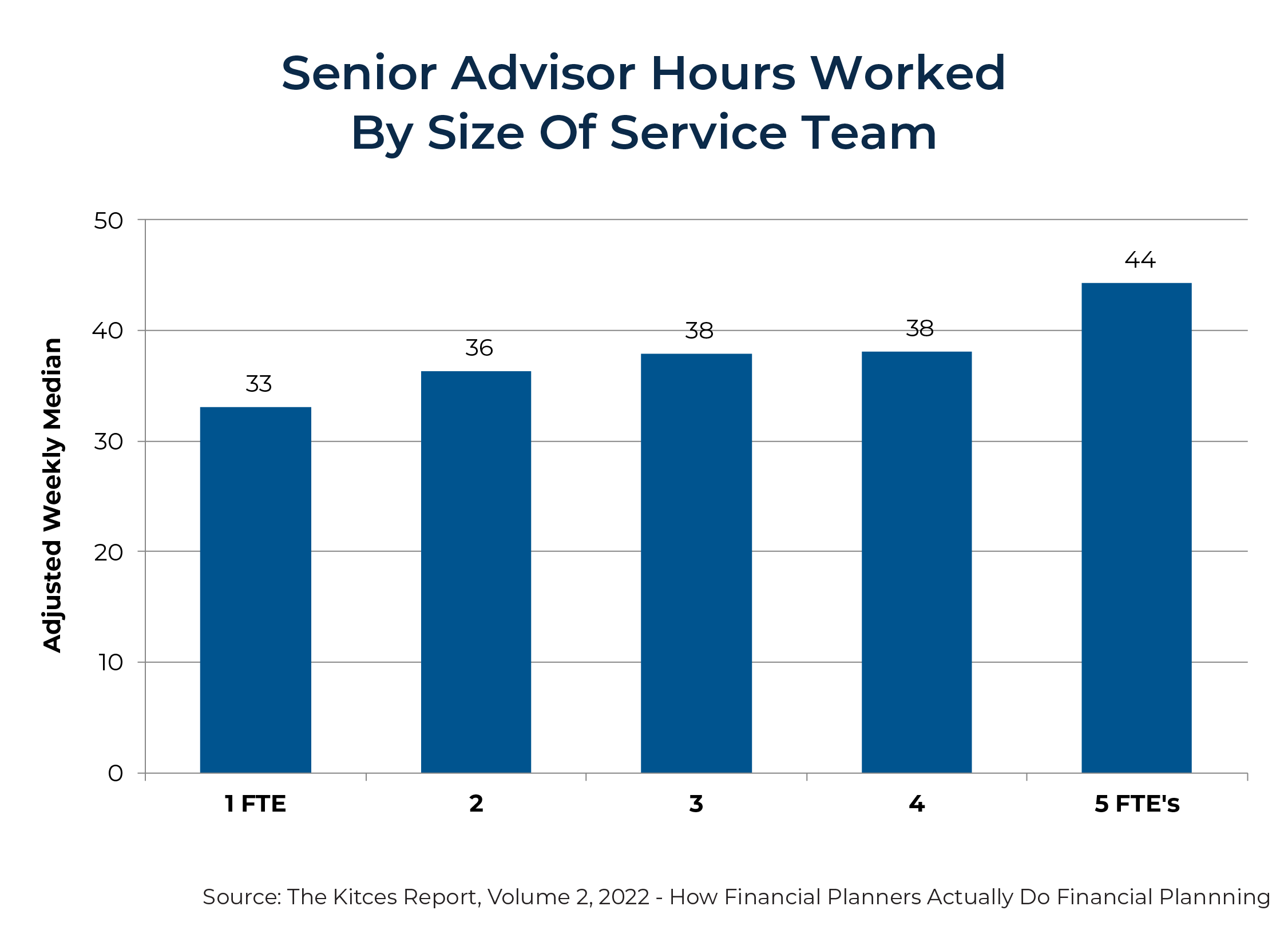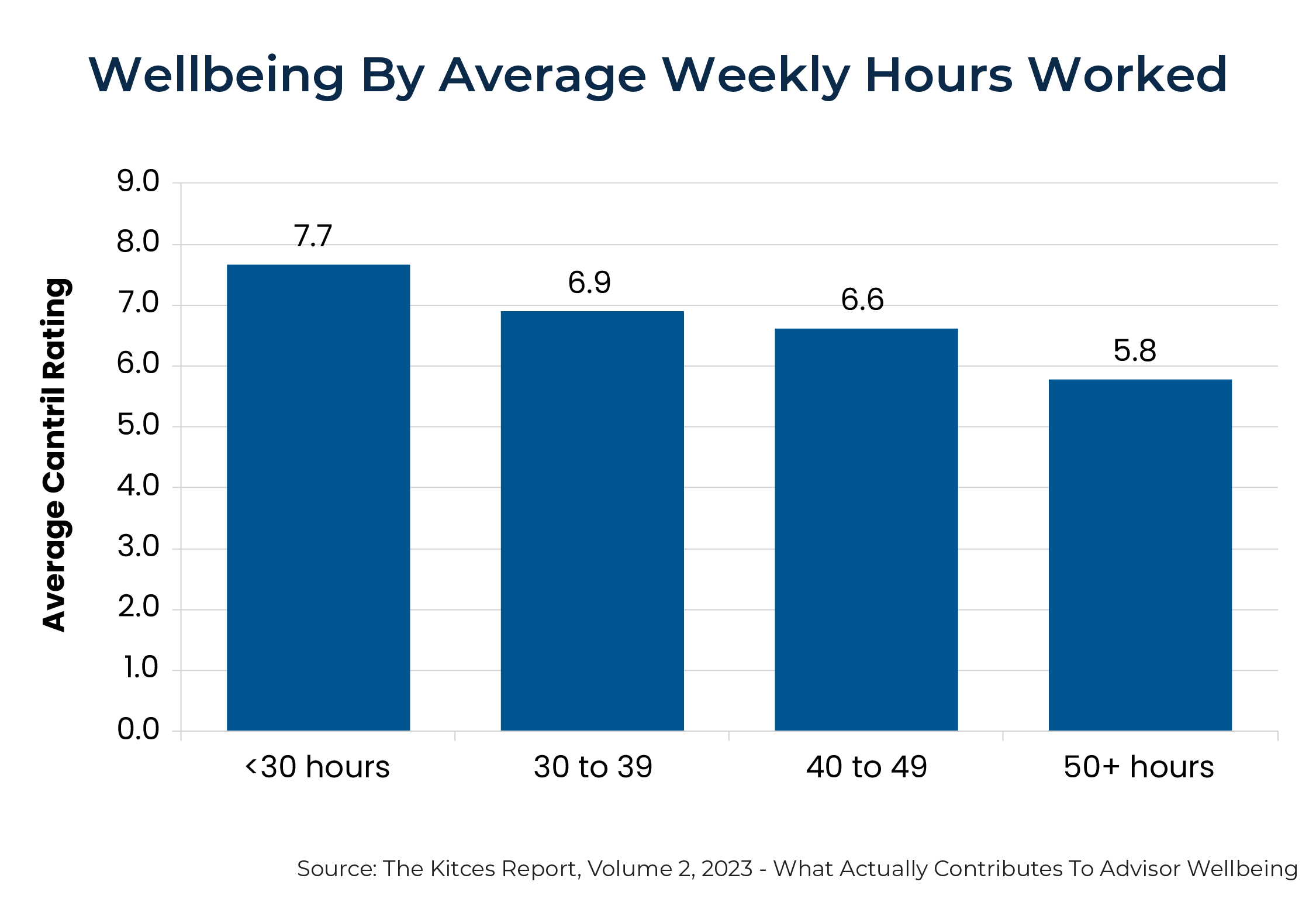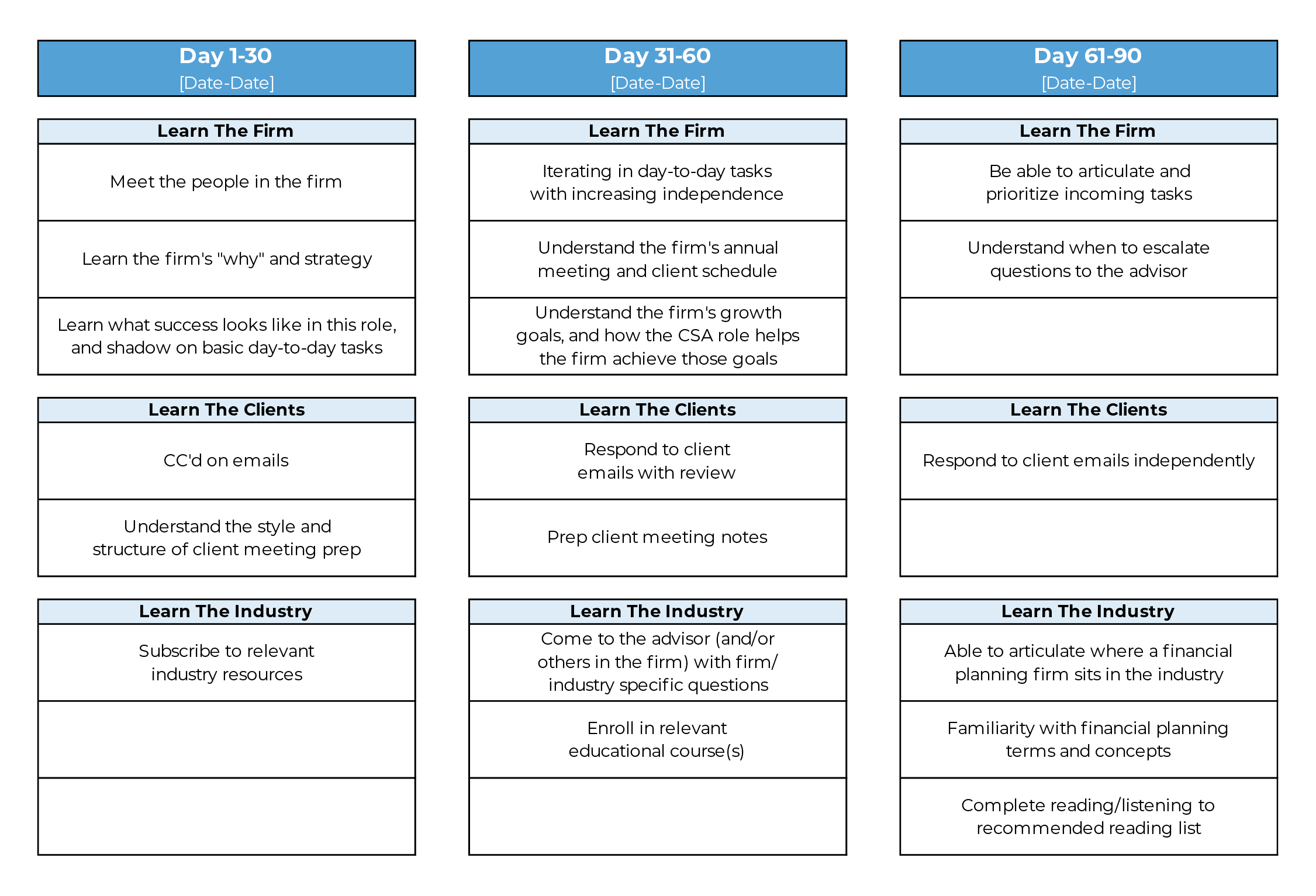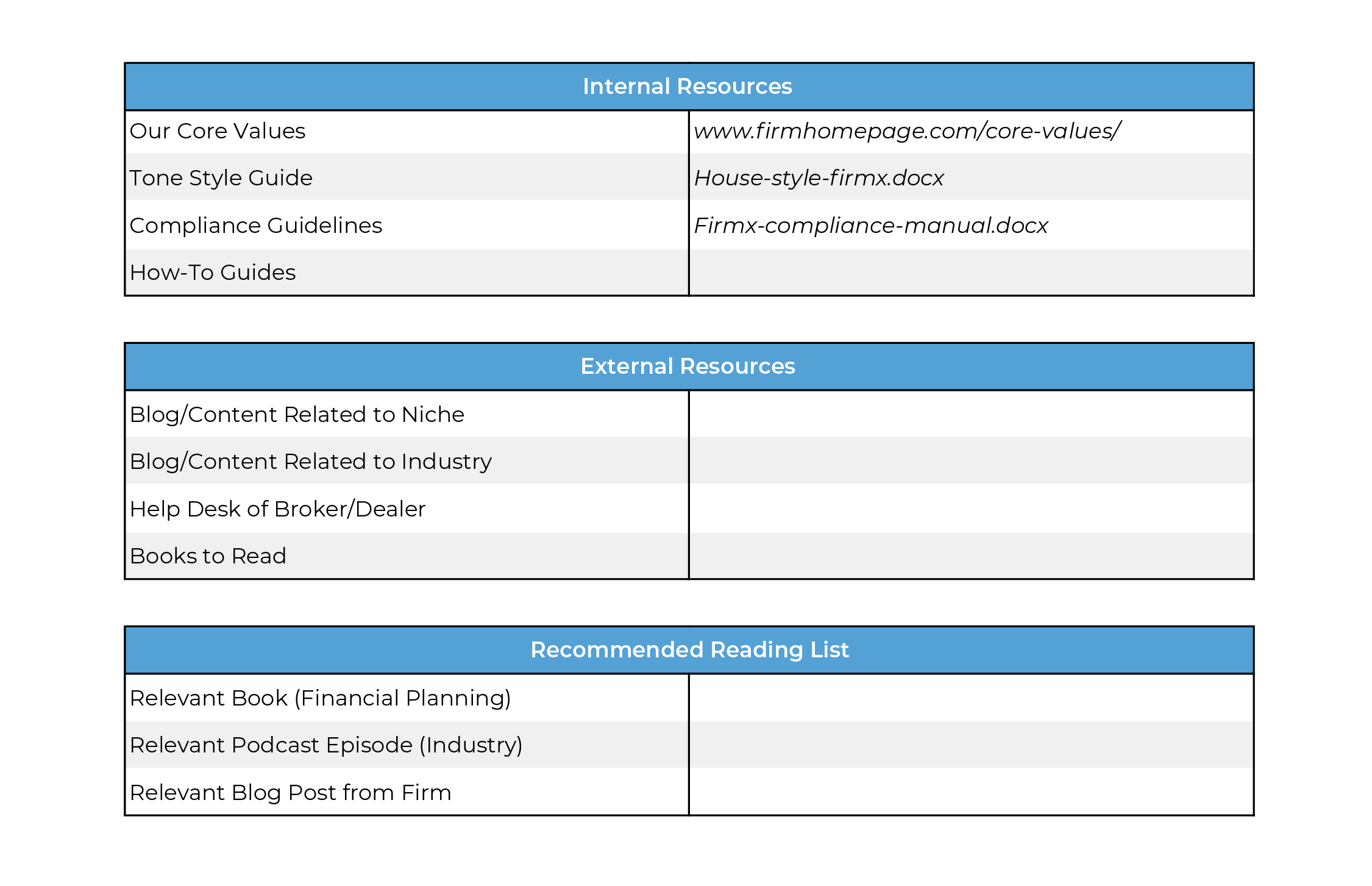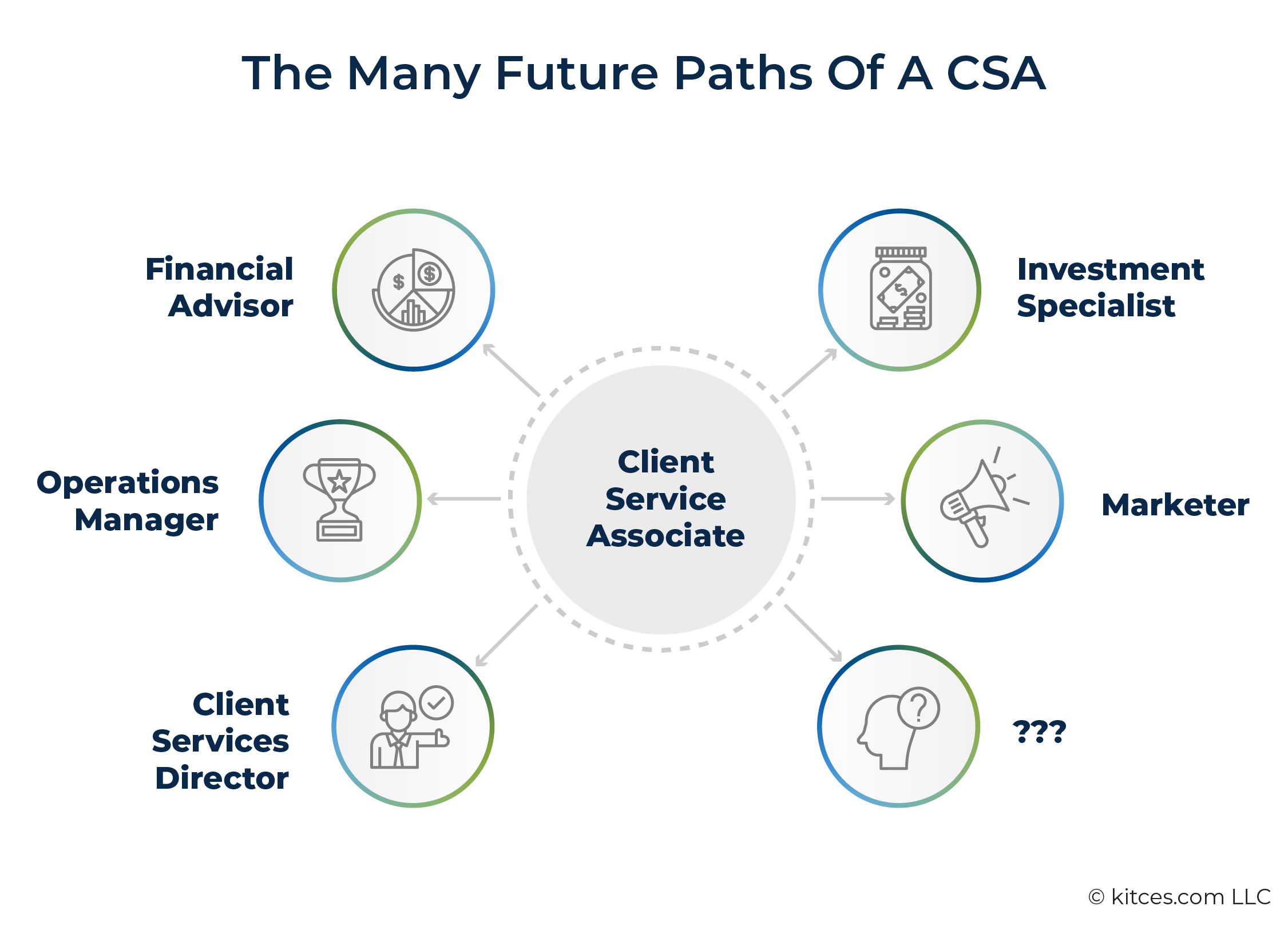Executive Summary
For small advisory firms that are beginning to grow and ready to add new staff, a Client Service Associate (CSA) or similar support role is a common early hire. Ideally, this person will free up an advisor's time to let them focus on other tasks (which are likely income-producing and will allow the advisor to continue to grow the firm). However, if a new CSA is not onboarded well, then advisors run the risk of taking on additional management responsibilities without a corresponding lift in task workload. This can also create a frustrating situation for the CSA, who likely wants to do their job, as well as for the advisor, who no longer has as much capacity to do their job!
Much of this frustration can be avoided with a clear onboarding plan. A good onboarding plan can bring clarity to the advisor (or hiring manager) on how much time will need to be spent with the new hire, what order to present information in, and when an advisor can plan to 'let go' of and finally delegate different tasks to the CSA. Likewise, a well-designed onboarding plan can help the CSA understand the timeline and short-term expectations for success, as well as provide them with an easy reference point for crucial resources.
The majority of learning that CSAs need to do for their role often falls into 3 areas: understanding the firm (e.g., the firm's schedule, processes, and people), getting to know the clients (e.g., individual client preferences), and gaining industry knowledge (e.g., technical terms as well as where the firm sits in the broader financial advice industry). Advisors can structure onboarding tasks and measurables around those 3 segments. For example, in order to learn about the industry, a CSA may need to subscribe to relevant publications or enroll in a publication program. Another resource that may make a difference as a part of the onboarding plan is a list of resources, including internal resources and the link to contact the help desk of the firm's broker-dealer. Additionally, CSAs may benefit from a 'people guide' that identifies important relationships to the firm, such as centers of influence.
As the onboarding process continues, advisors can be transparent about which processes are crucial to the firm's workflows or the value proposition to the client, and which are flexible to be adapted as the CSA gets more comfortable. Furthermore, adapting how instruction is given to how the CSA learns, and prioritizing synchronous learning by inviting the new hire 'into the room' and letting them sit in on client meetings, strategy conversations, or other crucial conversations can make an enormous difference in a new employee's long-term retention and ability to give good strategic input.
Ultimately, the key point is that onboarding a CSA requires thoughtful planning and an upfront investment of time. But with clear structure, flexibility, and engagement, both the advisor and CSA can have a pleasant and efficient onboarding experience that can lead to a more rewarding and productive partnership in the long run!
The marathon of hiring – creating a job description, running an interview process, reviewing work samples, and still maintaining one's standard duties – can be overwhelming, especially for smaller firms without an established process. While an advisor may feel relieved when the new hire arrives (because finally, a person has entered to help handle things!), the reality is that while the new person may be a competent and driven individual, they don't yet know how to do their job as this advisory firm would like it to be done.
And the world doesn't stop spinning for the advisor and their team to run a hiring process. Getting through the work of hiring while still maintaining one's own full-time work may make an already-busy advisor feel overwhelmed right as the new hire joins in. As a result, time to onboard and train a new hire can be scarce.
I've been in this situation myself – as a manager, the build-up between determining that I needed a full-time employee to fill a brand-new role, interviewing people, reviewing work samples, and hiring that person was so great that the work on my plate was enormous. By the time my new hire actually joined, months of work had piled up. I'm not proud of it, but our onboarding conversations in their first days of work basically went like this:
Me: Thank goodness you're here! OK, so… everything is on fire. Here's a list of tasks, and here's where to save everything. I have to run. You've got this! Welcome to the team!
New Hire: Oh, OK.
As one might imagine, this approach stretched out the onboarding process and led to some setbacks:
- It took longer for this person to gain confidence in their tasks.
- It took even longer for them to understand why they were doing their tasks.
- Because it took longer to onboard the new hire, it took me longer to feel a lift because I was still managing parts of their workload.
- Managing their workload and managing them left me feeling frustrated and overworked.
- Because they weren't clear on what to do or how to do it, they felt frustrated, underutilized, and disconnected from the team.
The Challenges Of Onboarding New Hires
At Nerd's Eye View, we've written extensively about the capacity crossroads – when an advisor's business nears the maximum number of clients they can manage as a solo advisor. This crossroads arises, on average, when revenue reaches around $200k–$300k or the advisor manages 30–40 clients, though this varies by an advisor's preferences and processes.
When an advisor approaches this crossroads, they generally face 3 broad options:
- Remain solo, bringing in new clients only as needed;
- Grow into a boutique firm with a few full-time employees; or
- Grow into an enterprise with many full-time employees.
For 2 of these 3 options, the next step would be to hire. According to the latest Kitces Research on How Advisors Actually Do Financial Planning, the most common second hire is a Client Service Administrator (CSA). The study found that 60% of advisory firms had a CSA – making it the second-most common role, second only to senior advisors themselves.
Nerd Note:
The Client Service Associate (CSA) role goes by many names. In my interviews with advisors and advisory firm staff, I've met many people with a variety of titles who filled this role, including client service specialists, paraplanners, and operations assistants, among others.
In this article, "CSA" is used as an umbrella term to refer to a role focused primarily on servicing clients without being directly involved in 'doing' financial planning (for example, they might be responsible for filling out client paperwork, answering client emails, and supporting both clients and the advisor). Some firms, especially smaller ones, may have CSAs who wear multiple hats. These individuals might be referred to as a "CSA and…" e.g., "CSA and Marketing Assistant" or "CSA and Operations Assistant".
So, consider an advisor who realizes they are approaching the capacity crossroads and determines they have both the cash flow and inclination to hire a CSA. They go through the interview process, find someone who's a great fit for the firm, and make the hire. Great, right? Now an advisor can delegate more of their workload and focus more of their time and energy on other (likely revenue-generating) priorities for the firm.
However, the 2022 Kitces Research on How Advisors Actually Do Financial Planning found that with each additional employee, an advisor actually worked more hours, not fewer. For example, a senior advisor at a 2-person firm (themselves and 1 additional hire) works 9.4% fewer hours than an advisor at a 3- or 4-person firm.
Why does this matter? First, it's common to hire with the idea of alleviating time stress. Second, the total hours worked have a significant impact on an advisor's wellbeing. In Kitces' 2023 What Actually Contributes To Advisors' Wellbeing study, there was "a nearly linear negative correlation between average weekly hours worked during the course of a year and an individual's well-being". Using the Cantril Self-Anchoring Scale, respondents were asked to rate their wellbeing on a scale of 0–10, with the best possible life represented by 10 and the worst possible life represented by 0. Advisors' self-reported well-being fell by 0.5 for every additional 10 hours worked per week.
Why Adding Employees Leads To More Hours (Not Less)
To some, it may feel counterintuitive that adding employees leads to more hours worked for senior advisors. After all, more people on the team should mean more productivity spread across more people, which should reduce the cumulative demands on an advisor.
Unfortunately, this is rarely the case. Part of this can be attributed to the additional management, business, and compliance responsibilities that naturally come with hiring an employee (plus, rumor has it that many employees want things like benefits and growth plans, all of which take time and energy to sort out and explain… which, at small firms, often falls on the senior advisor or firm owner).
Onboarding new hires is also time-consuming – and often takes longer than people anticipate. Small firms, which are often "building the plane while it's flying", may struggle to create an effective onboarding process, especially when it's being re-invented with each new employee. The challenge of creating a plan that coordinates a new hire's integration into both their role and the company as a whole is often something that a time-squeezed advisor simply doesn't have the bandwidth to do… even if they wanted to.
Additionally, even when a CSA (or other new hire) is learning things in the right order, it can be difficult for an advisor to know when to delegate. Many advisors work hard to build relationships with clients – and this may feel especially vulnerable for a fledgling firm that has mostly been just the advisor and clients. So, taking that next step and knowing when to step away when client relationships (and, therefore, revenue) are on the line can be daunting.
All of this is to say that advisors often hire with the idea of expanding their firm (which is a big reason they cut into their revenue to hire in the first place!), so they're often taking on new tasks to help the firm grow. This can look like hosting more events, making more prospecting calls, and connecting with more centers of influence (COIs). If a CSA hasn't been onboarded well and isn't operating smoothly, the advisor may find themselves stuck juggling old lingering tasks and their new responsibilities.
However, onboarding CSAs doesn't have to be this way. Advisors who can organize their onboarding process and focus on delegation are more likely to have a smooth advisory onboarding experience.
The 3 Types Of Information CSAs Need To Do Their Job Well
The information an onboarding CSA needs to learn can be sorted into 3 categories, as discussed in the following sections.
Understanding The Financial Services Industry
First and foremost, new CSA hires may need to learn about the financial advice industry. While some may have previous experience in certain areas of the finance industry, like banking, the financial advisory space comes with its own set of technical complexities. Even those who have been in the financial services space for years may find there's a lot to learn about the specific processes and considerations in the field. There's a difference between a client understanding how a decision may impact their situation and an employee who needs to understand and explain to them how to execute it and why.
A solid technical foundation is key. Since CSAs work directly with clients' money, mistakes can be costly – not only in terms of a client's trust but also (in more extreme cases) in terms of impacting what is often the cumulative savings of clients' lives. But a CSA who understands not only what they know but also what they don't know, and who (and when) to ask for help, can work incredibly effectively to keep both an advisor and clients unblocked.
Thus, a part of understanding the financial services industry is developing a network of people and resources, which often includes the financial advisor as well as a broker/dealer's (or equivalent) help desk. Finally, there's no real substitute for firsthand experience and actually being in the room: Being present for client meetings, attending conferences, and pursuing educational opportunities are crucial to fully understanding the industry.
Understanding The Firm's Processes And Philosophy
In that same vein, while some CSAs may have had prior exposure to the financial planning world, every firm 'ticks' slightly differently. Various factors – like broker/dealers, trading platforms, advisor preferences, and even state legal requirements – can drastically change the process of how CSA work is done. And, while some processes are inevitably built via the time-tested "I did this 1 time at 6:00 PM on a Friday and told myself I'd figure out a better way later, but now it's just our process " method (I see you; I've been there), others are painstakingly built, and how they are developed is in fact crucial to the firm's philosophy and mission.
Thus, part of the CSA's challenge is to learn the following:
- Where information and resources are stored for handling client requests;
- How processes are carried out (and when exceptions apply); and
- Why things are done this way (and perhaps especially if and how this impacts the value a firm gives to clients).
Another key aspect is understanding the firm's overall culture. For small firms, the culture may still be in its early stages, and the new CSA may have an outsized impact on shaping what it will become. In other, more established firms, there may already be well-defined norms for a new hire to learn and adapt to.
Nerd Note:
In many of my interviews, managers and leaders across a spectrum of firm sizes reflected on a key hiring dilemma: Should they pay less for a less experienced (or inexperienced) CSA and train them on the job, or pay more for a more experienced CSA who generally knows what to do, but may need to be trained on how to do it? How a leader weighs these considerations against the time it takes to train and onboard a person, along with their 'trainability', cultural fit, and aptitude, can be a complex puzzle to navigate!
Understanding The Firm's Clients
Finally, many advisors hire a CSA with the goal of having them be the responsive 'first face' clients see – the name in the email signature and the voice on the phone. Understanding the firm's norms and values is crucial, but CSAs must also understand the unique dynamics of individual client relationships. This may include information such as the following:
- Client preferences in meetings (e.g., Elizabeth doesn't drink coffee, so offer water instead; Clint doesn't like small talk and just wants to get straight to business).
- Client preferences and "fun facts" (e.g., Diana met her wife at a pottery club; Peter is a baseball aficionado and especially loves the Yankees).
- Recent life events (e.g., Neal just moved to New York for work).
This type of information often forms the foundation of making clients feel individually seen and cared for on a personal level. A CSA with access to this information can ask Peter if he's been to any spring training baseball games lately or check in with Neal on how he's settling into New York life. But as relationship-oriented information is easy for an advisor to just hold in their head or only mention in passing, it must be consciously and consistently shared with the CSA.
If the advisor hasn't already done so, this information is typically best stored in a CRM. Life events and client meeting preferences can both be logged as simple bullet points.
How To Onboard A New CSA Scalably
The 3 categories that a CSA needs to learn – the financial services industry, the firm's processes, and the firm's clients – can mold the onboarding strategy for a new CSA. 90 days is usually a good timeframe to budget for the heavy lifting involved in onboarding. While new CSAs may not encounter every client scenario in those 90 days, an advisor can plan to delegate the majority of the day-to-day CSA work within that time.
Pre-Onboarding: Using The Onboarding Plan Template
Before the new CSA starts, the advisor can do work up front to ensure that things go as smoothly as possible by developing a 90-day onboarding plan. In the template below, the onboarding plan is divided into 30-day blocks (with a separate page to break down the first 4 weeks in more detail). This allows the advisor and CSA to track what has and hasn't been discussed, offering a good roadmap for general expectations.
While the template includes onboarding suggestions, advisors can modify it to reflect what the CSA actually needs to learn in order to succeed at their specific firm. A good general guideline is that by the end of the 90 days, the new CSA should have a broad understanding of how the firm is organized and its overarching vision, how to perform day-to-day tasks, and where to go for answers (and when to escalate issues).
The inherently cyclical nature of financial planning means that most CSAs won't have seen all of the recurring client scenarios by the end of 90 days (e.g., a CSA onboarded in February won't have a chance to provide end-of-year support work for a while!). Generally, it can take 18 months for a new hire to see (almost) everything. So, the key question becomes, "How can I quickly teach my CSA to understand the nuances of my firm and clients?"
(As an aside, if advisors have some flexibility in their hiring timeline, they may consider onboarding during their 'slow season' if possible. For instance, onboarding and training a CSA during tax preparation season may be more overwhelming than helpful.)
The downloadable template can serve as a foundation for developing a customized onboarding plan. If they have capacity, advisors may want to block off a few hours each week before the new CSA starts to develop what they can – especially if this is their first time hiring.
Providing Resources For New Hires
The final tab in the 90-day onboarding plan is Resources, which comprises articles, videos, or internal documents for a new CSA to digest as they onboard. It may involve something as simple as a glossary of financial investment terms or links to common resources – such as the help center of a firm's broker-dealer (or equivalent platform). Alternatively, advisors may want to link to books or other resources that explain the firm's philosophy or address common problems that clients generally encounter.
In short, common resources include:
- Blogs or other publications that explain the firm and financial planning sphere. If the firm publishes its own work, it may want to consider linking to its 'MVP' articles;
- Blogs or other publications that relate to the firm's specialty;
- A brief overview of who's who – centers of influence, mentors, contractors, or other people the CSA needs to be aware of;
- Broker/dealer help centers or other resources for when a CSA needs help; or
- Links to the house style guide and mission statement.
Documenting Processes And Reasoning In Real Time
A key component of a successful CSA's role is responding to client inquiries, which can vary widely. In the time between deciding to hire a CSA and actually onboarding one, it may be helpful to record tasks as they're being done. For example, while entering a new client's information, it may be easier to have a Word document open and jot down the standard step-by-step process (e.g., where to go, what to do, etc.) in real time rather than trying to recall all the steps later. Furthermore, a few sentences (written or recorded) about why a particular step is done that way can help CSAs internalize the firm's overall purpose and mission.
Recording software such as Scribe (which automatically creates step-by-step documentation of a recording, complete with screenshots) or Loom can also be useful, as long as advisors ensure that the recordings are secure or that sensitive client information is removed.
When creating step-by-step guides, it's easy to get bogged down by exceptions, so aim to cover 80% of the scenarios that are most common and note exceptions where necessary.
Ultimately, this documentation is a 'nice-to-have' and can be created collaboratively with the CSA during the onboarding process. However, having a little bit of documentation upfront can do a lot to alleviate the administrative burden down the line!
Determining What (If Any) Educational Requirements Are Needed
When stepping into a new role, hands-on experience can make a tremendous difference, particularly for those who are entering the financial advice space for the first time. This can look like any blend of strategies, but 2 predominant approaches are to have the new CSA sit in on client meetings and to enroll them in an educational program to strengthen their technical skills.
The type of educational training that best suits the firm's needs will vary, but options to consider are the Series licenses, particularly 6, 7, 63, 65, or 66 – depending on if a CSA may need to assist with insurance or 'just' portfolio management.
Additionally, for CSAs interested in growing into more technical roles in the long term, advisors may consider having them start work on CFP certification.
While most training programs won't be completed within the first 90 days, they can be started during this time, with a timeline for completion agreed upon.
The First 90 Days Of Onboarding
While a CSA's first day of work can feel like the opening of a new chapter, for the advisor, it can feel like they've just finished a marathon – having gone through the entire process of job posting, interviewing, and hiring. It's important to start the onboarding process with good energy to help the new CSA feel welcomed, but it's also worth taking a moment to celebrate the achievement of getting this far!
Day 1–14: Orientation To Industry And Company
Within the first few days, share the customized onboarding plan with the CSA and walk them through what to expect. Define what success looks like at key milestones: 30 days, 90 days, 6 months, and 1 year. Outline which tasks the CSA should be handled by each point and the strategies they should incorporate into their daily routine. Since CSAs can wear many hats (e.g., administrative assistant or office manager), being explicit about what success looks like in the role is crucial.
The first 2 weeks will involve a lot of getting situated – accessing the firm's software programs, being cc'd on emails, and generally getting oriented with the firm. During this time, the CSA will generally be shadowing the advisor, watching how they do tasks, asking questions, and familiarizing themselves with the day-to-day workflow. A good objective at this stage is to work on rounding out the onboarding tasks. The advisor can even task the CSA with documenting the processes themselves. CSAs can also use this time to review the resources provided in the 90-day onboarding plan and bring any questions to the advisor.
In general, during these first 2 weeks, plan to meet with the CSA for at least 1 hour daily, not counting shadowing time.
To help the CSA integrate well, make sure they meet not only with full-time employees but also with the contractors and remote workers who play important roles in the firm. Understanding what these individuals do within the firm is critical to grasping the full scope of the firm's operations.
In these first few weeks, consider inviting the CSA to meetings that may be outside their general job description. The more context they have for how the firm ticks, the better they'll perform in the long run. For example, CSAs who shadow client meetings often report that it made an instrumental difference in understanding what really matters to clients.
CSA Action Items: Meet with everyone in the firm; learn the firm and its culture; update documentation while learning.
Advisor Action Items: Explain the firm's clients and the firm's "why"; meet with new CSA at least daily; explain short- and long-term goals for success.
Day 15–30: Acting With Supervision
During the second 2 weeks, the new CSA can begin taking on work more proactively, but with oversight from the financial advisor to ensure that the CSA's work is accurate and aligns with the firm's tone. When giving feedback, be clear about the "why" behind it so that the CSA understands what they did right (or wrong). Advisors may also begin introducing clients to the CSA at this stage, allowing the CSA to begin building independent relationships with clients.
The CSA can continue to document processes, gaining a deeper understanding of the firm's clients and learning more about the financial planning industry. If additional education is part of the CSA's training, now is a good time for them to enroll and begin taking classes.
CSA Action Items: Begin operating on common action items with supervision; continue updating documentation; start educational components, if any.
Advisor Action Items: Review processes and work done; give feedback on the why and the firm's purpose.
Day 30–60: Understanding The Why
After the first 30 days, formal meetings between the CSA and advisor may become less frequent – typically twice a week rather than daily (other than time spent shadowing). Generally, at this stage, CSAs are handling the repetitive day-to-day tasks with increasing independence and confidence; though the advisor continues to monitor, fewer mistakes are being made, and reviews are completed more quickly.
During this time, advisors can start training CSAs on the more advanced tasks that weren't covered in the first 30 days, as client needs arise or as the CSA hits their stride. For example, the advisor may have covered meeting prep and basic paperwork in the first 30 days; now, in the second 30 days, they can delegate more advanced tasks and teach the CSA how to set priorities as new tasks come in.
In this second month, conversations about time and task management become particularly crucial. As CSAs continue to learn, they'll need to develop a stronger understanding of how to contextualize and prioritize the requests and client questions.
CSA Goals: Gain confidence and reduce errors; understand what to prioritize.
Advisor Goals: Delegate larger day-to-day tasks; focus on contextualization.
Day 60–90: Working With Decreased Supervision
By the third month, the goal is for the CSA to handle day-to-day tasks with increasing comfort and independence. At this point, the key goal is to ensure that the CSA understands what they can solve on their own, what can be addressed using resources like a B/D help page, and what needs the advisor's review. Encourage the CSA to reach out when in doubt – while it's natural to feel pressure to excel quickly in a new role, the cost of making mistakes can be high.
From here on out, the CSA may begin to take on the role of the "point person" for client communication. For many firms, the long-term goal is for clients to feel just as comfortable reaching out to the CSA as they would to their advisor – if not more. Building strong client relationships and trust while maintaining the firm's communication standards is key.
By this stage, the advisor should begin experiencing a substantial lift in their day-to-day workload. A crucial part of delegation is not only handing off tasks but also easing the mental burden of those tasks as the CSA gains more experience. It's important to be clear with the CSA (and celebrate!) when the advisor is comfortable no longer reviewing certain tasks. At the same time, it's important to be explicit when an issue should still be escalated to an advisor.
CSA Goals: Begin to operate independently in some areas; build relationships and trust with clients.
Advisor Goals: Explicitly begin to 'not watch' tasks that the CSA is excelling at; look for lift; encourage questions and growth.
Post-90 Days: Discussing Success Going Forward
As the CSA nears the end of their first 90 days, it's important to celebrate their achievement and discuss what success looks like going forward. From here, the priority for the advisor is to train and continue delegating as new processes and tasks arise. Many new CSAs may appreciate an overview of the next year, with approximate timelines for continued independence, particularly busy seasons, and other unique firm events.
Other Notes For Success
Overall, onboarding a CSA doesn't have to be a daunting task. Yes, it will take time, but it's absolutely doable and can result in a substantial lift for the advisor. In my interviews with CSAs and their managers, several high-level lessons consistently stood out:
- Make it easy for the CSA to ask questions. Starting a new job can come with pressure to excel immediately. Create an environment where the CSA is comfortable asking questions and err on the side of being a supportive and compassionate resource.
- Understand the CSA's learning style. Everyone has different communication styles and learning styles. Some CSAs will be comfortable with change and ask rapid-fire questions; others may be 'slow processors'. Ask the CSA how they prefer to work and learn, and, when possible, adjust your approach to meet their preferred learning style.
- Document the process during onboarding and be transparent about improvements. Explaining processes to a new hire can reveal inefficiencies in a firm's workflows. Being clear with the CSA about which steps are crucial and where improvement is needed creates an opportunity to work together on making those processes better. Rather than waiting for everything to be perfectly in place before onboarding the CSA, involve them in improving the workflows. Let them help identify areas for improvement and adapt the processes to suit their particular working style as they settle into the role.
- Expect that something will probably be forgotten in the onboarding process… and know that it's OK. No onboarding process is perfect. Aim to capture the crucial elements that must be done correctly, make it clear where additional information can be found, and acknowledge if something is missed.
- Be prepared for the CSA role to grow and evolve. A part of the nature of small firms is that the company can completely change every few years. In my interviews, I talked with CSAs who became operational directors, financial advisors, and researchers – but there are many paths available to detail- and task-oriented CSAs who truly learn the industry!
Ultimately, whether a CSA is just entering the industry or has several years of experience in wealth management, both their professional aspirations and the firm's opportunities are likely to evolve. When a firm's growth aligns with a CSA's interests, it can lead to longer retention – plus, the CSA can eventually help train the next new hire as they pivot into their own expanded role!
Finally, remember the human element – not just in the CSA, but also in the advisor who's training them. Things won't always go perfectly, and that's OK. By keeping a growth-oriented mindset, maintaining a good sense of humor, and focusing on growing together as individuals and as a firm, a stronger, more successful team can be built in the long run!
Thank you to the many people who generously shared their time, experiences, and expertise and shaped the content of this article, including (but not limited to) Mark Tenenbaum and Ben Henry-Moreland of the Kitces.com team; Lauren Hughes, Betsy Wolking, and Lindsey Keith at Foster & Motley; Lauren Hong at Out & About Communications; and Azadeh "Ozzie" Ward and Jack Heintzelman at Boston Wealth Strategies.


